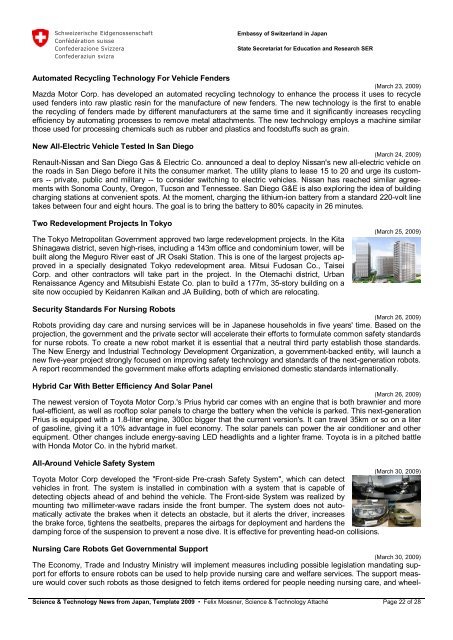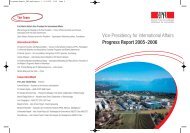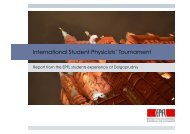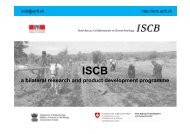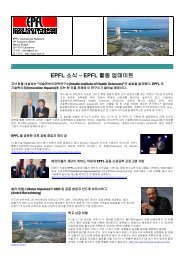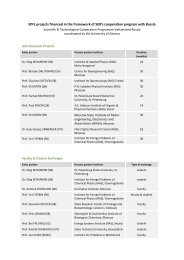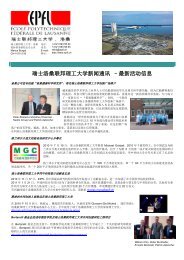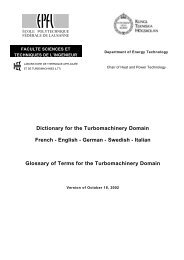Science & Technology News from Japan - International Relations
Science & Technology News from Japan - International Relations
Science & Technology News from Japan - International Relations
You also want an ePaper? Increase the reach of your titles
YUMPU automatically turns print PDFs into web optimized ePapers that Google loves.
Schweizerische Eidgenossenschaft<br />
Confédération suisse<br />
Confederazione Svizzera<br />
Confederaziun svizra<br />
Embassy of Switzerland in <strong>Japan</strong><br />
State Secretariat for Education and Research SER<br />
Automated Recycling <strong>Technology</strong> For Vehicle Fenders<br />
(March 23, 2009)<br />
Mazda Motor Corp. has developed an automated recycling technology to enhance the process it uses to recycle<br />
used fenders into raw plastic resin for the manufacture of new fenders. The new technology is the first to enable<br />
the recycling of fenders made by different manufacturers at the same time and it significantly increases recycling<br />
efficiency by automating processes to remove metal attachments. The new technology employs a machine similar<br />
those used for processing chemicals such as rubber and plastics and foodstuffs such as grain.<br />
New All-Electric Vehicle Tested In San Diego<br />
(March 24, 2009)<br />
Renault-Nissan and San Diego Gas & Electric Co. announced a deal to deploy Nissan's new all-electric vehicle on<br />
the roads in San Diego before it hits the consumer market. The utility plans to lease 15 to 20 and urge its customers<br />
-- private, public and military -- to consider switching to electric vehicles. Nissan has reached similar agreements<br />
with Sonoma County, Oregon, Tucson and Tennessee. San Diego G&E is also exploring the idea of building<br />
charging stations at convenient spots. At the moment, charging the lithium-ion battery <strong>from</strong> a standard 220-volt line<br />
takes between four and eight hours. The goal is to bring the battery to 80% capacity in 26 minutes.<br />
Two Redevelopment Projects In Tokyo<br />
The Tokyo Metropolitan Government approved two large redevelopment projects. In the Kita<br />
Shinagawa district, seven high-rises, including a 143m office and condominium tower, will be<br />
built along the Meguro River east of JR Osaki Station. This is one of the largest projects approved<br />
in a specially designated Tokyo redevelopment area. Mitsui Fudosan Co., Taisei<br />
Corp. and other contractors will take part in the project. In the Otemachi district, Urban<br />
Renaissance Agency and Mitsubishi Estate Co. plan to build a 177m, 35-story building on a<br />
site now occupied by Keidanren Kaikan and JA Building, both of which are relocating.<br />
(March 25, 2009)<br />
Security Standards For Nursing Robots<br />
(March 26, 2009)<br />
Robots providing day care and nursing services will be in <strong>Japan</strong>ese households in five years' time. Based on the<br />
projection, the government and the private sector will accelerate their efforts to formulate common safety standards<br />
for nurse robots. To create a new robot market it is essential that a neutral third party establish those standards.<br />
The New Energy and Industrial <strong>Technology</strong> Development Organization, a government-backed entity, will launch a<br />
new five-year project strongly focused on improving safety technology and standards of the next-generation robots.<br />
A report recommended the government make efforts adapting envisioned domestic standards internationally.<br />
Hybrid Car With Better Efficiency And Solar Panel<br />
(March 26, 2009)<br />
The newest version of Toyota Motor Corp.'s Prius hybrid car comes with an engine that is both brawnier and more<br />
fuel-efficient, as well as rooftop solar panels to charge the battery when the vehicle is parked. This next-generation<br />
Prius is equipped with a 1.8-liter engine, 300cc bigger that the current version's. It can travel 35km or so on a liter<br />
of gasoline, giving it a 10% advantage in fuel economy. The solar panels can power the air conditioner and other<br />
equipment. Other changes include energy-saving LED headlights and a lighter frame. Toyota is in a pitched battle<br />
with Honda Motor Co. in the hybrid market.<br />
All-Around Vehicle Safety System<br />
Toyota Motor Corp developed the "Front-side Pre-crash Safety System", which can detect<br />
vehicles in front. The system is installed in combination with a system that is capable of<br />
detecting objects ahead of and behind the vehicle. The Front-side System was realized by<br />
mounting two millimeter-wave radars inside the front bumper. The system does not automatically<br />
activate the brakes when it detects an obstacle, but it alerts the driver, increases<br />
the brake force, tightens the seatbelts, prepares the airbags for deployment and hardens the<br />
damping force of the suspension to prevent a nose dive. It is effective for preventing head-on collisions.<br />
(March 30, 2009)<br />
Nursing Care Robots Get Governmental Support<br />
(March 30, 2009)<br />
The Economy, Trade and Industry Ministry will implement measures including possible legislation mandating support<br />
for efforts to ensure robots can be used to help provide nursing care and welfare services. The support measure<br />
would cover such robots as those designed to fetch items ordered for people needing nursing care, and wheel-<br />
<strong>Science</strong> & <strong>Technology</strong> <strong>News</strong> <strong>from</strong> <strong>Japan</strong>, Template 2009 • Felix Moesner, <strong>Science</strong> & <strong>Technology</strong> Attaché Page 22 of 28


